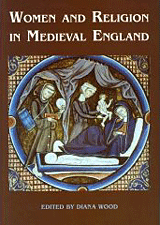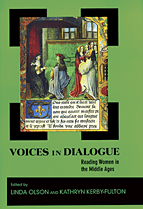Collectively these studies represent several very new angles of research, especially on Walter Brut and medieval sexuality, which make our understanding of medieval views of women and medieval sexuality much more complex: at times, perhaps, repression was greater than we might imagine (as per Somerset, Lochrie, and Hornbeck, below), while in some arenas women were more articulate than scholarship has understood (see Aston, Geertz-Robinson, and Minnis).

As always, if there are studies which have been omitted here, or if there is more to know, please add a comment below or send along a note. These are arranged in chronological order.
Margaret Aston, one of the first to open this line of scholarship with her 1980 article on “Lollard Women Priests?” published a new essay in 2003 entitled “Lollard Women” in Women and Religion in Medieval England, edited by Diana Wood, a collection of essays derived from a 2001 conference in Oxford. Aston especially focuses on what we know of the literate practices of women in Lollard communities, as “readers, teachers, and reciters” of religious texts.
In the same year, Genelle Christine Gertz-Robinson completed her dissertation, “Trying Testimony: Heresy, Interrogation and the English Woman Writer, 1400—1670″ (Princeton University, 2003). This spends most of its argument on the sixteenth and seventeenth centuries, but may provide a useful approach to examine Lollard women’s testimony. According to her abstract, the dissertation “tells the story of early modern women’s preaching: how it was suppressed, and the unexpected places it broke out. No place was more unexpected or important than the courtroom. Shrewdly understanding the public nature of trial, women writers turned discourses meant to incriminate them to their own instructional purposes. Chapters on medieval visionary Margery Kempe (fl. 1438), Protestant reformer Anne Askew (d.1546), and Quakers Katherine Evans (d.1692) and Sarah Cheevers (fl. 1663) show these women refashioning the courtroom audience into a congregation responsive to their clerical skills. This recovered tradition of women’s preaching revises scholarship on the medieval period that attributes women’s authority to visionary rather than textual knowledge, and reveals a new sphere of women’s eloquence on a par with Renaissance humanism.”
Theresa Colletti’s Mary Magdalene and the Drama of Saints: Theater, Gender, and Religion in Late Medieval England was published in 2004. Colletti briefly mentions Lollardy to say that “like many medieval reform movements, Lollardy was hospitable to women” (141), and that they were permitted to preach. She discusses Walter Brut’s use of Mary Magdalene “in his defense of women’s ability–and right–to preach as well as perform other priestly sacraments” (142), and argues that “Late medieval religious politics–of gender, preaching, and the vernacular–unquestionably shadow the public teaching of the Digby play’s Mary Magdalene” (147).
Norman Tanner also in 2004 published an entry in the Oxford Dictionary of National Biography on “Lollard Women.” This entry includes information on Anna Palmer (1393–1394), Christina More (1412–1414), Margery Baxter (1428–1429), Hawise Mone (1428–1430), Joan Washingby (d. 1512), Agnes Grebill (d. 1511), and Alice Colins (1521). There are, by the way, dozens of fresh entries in the new DNB on Lollards and their opponents that are helpful not just for their content but also the bibliography they provide.

Fiona Somerset’s essay “‘Eciam mulier’: women in Lollardy and the problem of sources” appears in Voices in Dialogue: Reading Women in the Middle Ages (2005); a response to her essay (“‘Eciam Lollardi’: . . .”) by Kathryn Kerby-Fulton, one of the volume’s editors, follows Somerset’s essay. Somerset notes that Lollard women were portrayed by orthodox opponents as either gullible, lascivious, or too feeble of wit to substantially contribute to religious life, fact which demonstrate Lollard error when men like Brut argued for women. The fears Somerset notes, by the way, resonate directly with those noted by Thomas in Bohemia (see below). But where then, Somerset asks, are these women? Brut’s claims for “women’s capacities,” she argues, “rather than providing any sort of evidence for support of women’s learning, . . . can helps us to understand why Lollardy was never a hospitable ground for the growth of extraordinary learning among women” (248). Somerset’s article goes on to consider two of the disputations from Trefnant’s Register in this light. Kerby-Fulton’s response does not disagree, but seeks “to open up a wide angle lens onto” the trial records, observing that the ideational concerns exhibited about women in the records is in fact wider than Lollardy alone as the disputations “show English scholars in contact with new continental ideas, and wrestling . . . with a new threat . . . that took them far beyond the concerns of even Lollardy” (263). Much of Kerby-Fulton’s response discusses these older and wider discussions about women and learning.
Alastair Minnis’s essay “‘Respondent Walterus Bryth . . .’: Walter Brut in Debate on Women Priests” is included in the festschrift for Anne Hudson (ed. Helen Barr and and Ann Hutchinson) in 2005. Minnis considers the theology of Brut’s arguments on women priests (recorded in Bp. Trefnant’s Register) in the light of Wyclif’s doctrine of dominion and its implication that the clerical hierarchy and righteousness do not coincide, but that righteousness was the only true authority.
Karma Lochrie’s Heterosyncrasies: Female Sexuality when Normal Wasn’t was published in 2006. Lochrie’s study makes Lollardy and women a central concern of her chapter three, “Far From Heaven: Nuns, Prioresses, and Lollard Anxieties.” The book overall focuses, as she says, “on female sexuality in the Middle Ages in an effort to discern a less binary, more diversified understanding of it.” Chapter three begins with the Lollard “Conclusion” that condemns female monastic vows of chastity as perversions. “For the Lollards,” she argues, “chastity served as a repressive trope of the church’s power, of its cultivation of a sphere of privacy, exclusion, and privilege, that included only on the male and female celibates, but a veritable ‘private religion,’ an institution that, instead of practicing Christ’s poverty and participation in the world, hoarded and withheld its wealth in its ‘dark recesses'” (50). Chastity, then, becomes associated with critiques of “idolatry and excessive materiality.” The Lollard argument, she notes, is not to eradicate sexual control as such, but rather “to valorize a different kind of regulation of female desire” (50) which posits chastity within marriage as an ideal. She turns later in the chapter to Chaucer’s Prioress “to argue that her representation is heavily indebted to the Lollard critique of female sexuality and that it further glances at Julian of Norwich and affective spirituality through the lens of Lollard polemics” (50-51). Lochrie’s argument, along with Carolyn Dinshaw’s in Getting Medieval and, now, Patrick Hornbeck’s noted below, is one of the only to examine Lollard (or, indeed, religious) writings to understand medieval sexualities, a critical interest which for medieval studies is mostly focused on romance or, more rarely, mystical writers.
Alfred Thomas published A Blessed Shore: England and Bohemia from Chaucer to Shakespeare in 2007. Thomas, whose earlier book on Anne of Bohemia also discussed Lollardy, here devotes two chapters to the movement’s effects in eastern Europe. Chapter 3, entitled “Master Adversary:’ Wyclif’s Influence in Bohemia,” traces “the reception of ideas” of Wyclif “with special reference to the thought of John Hus and Peter Chelčický, the two most prolific and articulate spokesmen of the Bohemian reform movement” (98). Hus, who was in fact much more conservative than Wyclif, was especially worried about church corruption; and Chelčický, in the next generation, was more radical than either Wyclif or Hus, espousing complete separation of church and state and an absolute pacifism.
Chapter 4 is “‘The Wycliffite Woman’: Reading Women in Fifteenth-Century Bohemia.” One problem, Thomas notes, “in reconstructing the historical role of women in the Hussite movement–and for that matter in English Lollardy–is the antifeminine and anti-heretical bias of most of the sources,” a point noted as well by Somerset, above. As a focus for his argument Thomas concentrates especially on the Czech anti-Hussite tract “Viklefice,” or “The Wycliffite Woman” (which he also discussed in his earlier book, and which he translates here in full) and much more briefly on a misogynistic Czech satire entitled “The Beguines.” Arguing against the critical assumption that “Bohemian women were innately drawn to Hussite teachings,” Thomas says that “a close attention to the medieval sources suggests that the situation of women in Bohemia was altogether more complicated” (122). Anxieties about female readership were “virtually inseparable from orthodox attempts to control lay access to the Bible” (132); Wyclif himself, in fact, had cited the example of of Anne of Bohemia’s ownership of several biblical translations in his De Triplici Vinculo Amoris [ed. Buddenseig, Polemical Works, vol. 1]; such anxiety, Thomas argues, is precisely what the imagery in “Viklefice” depicts.
Most recently, Patrick Horbeck has published “Theologies of Sexuality in English ‘Lollardy’” in the Journal of Ecclesiastical History 60.1 (Jan. 2009): 19-44. Rather than studying women alone, Hornbeck examines gender relations in “Wycliffite and Lollard views about sexuality and lay and clerical marriage. John Wyclif’s Latin writings reveal that he both professed caution about clerical marriage and articulated a culturally traditional theology of sexuality. Whereas his hesitation at the prospect of a married clergy gave way to enthusiasm among later dissenters, his ideas about lay sexuality resonated with dissenting and mainstream writers alike. The evidence calls further into doubt the view that Lollardy was an innovative movement with respect to issues of gender and sexuality.”
Full references to all of the studies mentioned here can be found on the Bibliography of Secondary Sources.